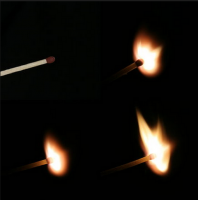








A noiseless match was invented in 1836 by the Hungarian Janos Irinyi, who was a student of chemistry.An unsuccessful experiment by his professor, Meissner, gave Irinyi the idea to replace potassium chlorate with lead dioxide in the head of the phosphorus match.He liquefied phosphorus in warm water and shook it in a glass vial, until it became granulated. He mixed the phosphorus with lead and gum arabic, poured the paste-like mass into a jar, and dipped the pine sticks into the mixture and let them dry. When he tried them that evening, all of them lit evenly.
Irinyi thus invented the noiseless match. He sold the invention to Istvan Romer, a match manufacturer. Romer, a Hungarian pharmacist living in Vienna, bought the invention and production rights from Irinyi for 60 forints (about 22.5 oz t of silver). Romer became rich and Irinyi went on to publish articles and a textbook on chemistry, and founded several match factories.